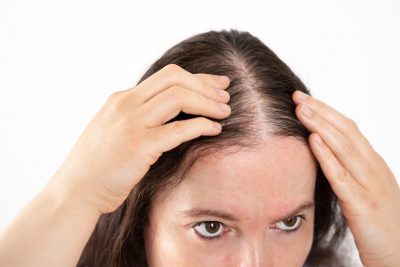Hair loss and balding is often perceived as something that only happens to men. In reality, it is estimated that women make up 40 percent of hair loss sufferers in the U.S., with one in four seeking treatment for hair loss annually. While a certain amount of hair shedding is normal in men and women alike, there is a notable difference in how society and culture perceive women experiencing excess hair loss.
men. In reality, it is estimated that women make up 40 percent of hair loss sufferers in the U.S., with one in four seeking treatment for hair loss annually. While a certain amount of hair shedding is normal in men and women alike, there is a notable difference in how society and culture perceive women experiencing excess hair loss.
Read on as we explore the stigma surrounding female hair thinning and loss.
Causes of Hair Loss in Women
The average human scalp has between 100,000 and 150,000 individual hairs and sheds roughly 100 to 150 hairs per day. Typically, new hair growth emerges from these same hair follicles at an average rate of half an inch per month as part of the normal pattern of growth. If this pattern is disrupted, hair does not grow back as readily as it normally would. Disruption can be caused by a multitude of reasons including:
- Pregnancy or the onset of menopause
- Genetics
- Surgery
- Extreme emotional stress
- Hormonal imbalance
- Chemotherapy
- Certain medications
- Harsh chemicals or aggressive styling
- Rapid weight loss
- Eating disorders
Social & Cultural Perceptions
Historically, society has identified thick, vibrant, full-bodied hair with a woman’s youth, femininity, beauty, desirability, and good health. Unfairly, dry, dull, lack luster, and thinning hair is identified with sickness, old age, and even poverty. The stigma can lead a woman to be in denial at the first signs of thinning or loss, obsess over her thin tresses, and cover up with wigs, extensions, or scarves. All the while feeling very much alone, not realizing just how common female hair loss is.
Phycological & Emotional Implications
While hair loss is not physically painful, it can cause severe psychological and emotional distress. Many women experience a significant decrease in self-esteem when their hair begins to fall out. Some suffer from depression, become introverted, and withdraw from social and intimate interactions. Their personal and business relationships may also suffer. Although men may become quite dismayed by a bald spot or receding hair line, research shows that they don’t suffer the same psychological pain, stigmatization, and subsequent consequences as women.
When to Seek Help
If you’ve noticed a sudden, gradual, or progressive increase in the number of hairs lost when combing, brushing, or showering, speak to your healthcare professional. Hair, along with skin and nails, is one of the first areas to reflect a health concern such as hormone imbalance, nutritional deficiency, or illness. Your physician can help determine whether your hair loss is due to an underlying medical condition or a result of genetics and aging. Once a cause has been identified, you may be referred to a specialist to learn about available treatment options. In some cases, hair may resume normal growth without and treatment or intervention.
In the case of permanent hair loss, turn to Distefano – New England’s top hair restoration center. Our experienced, passionate staff is dedicated to helping people just like you take charge of their appearance and improve their self-esteem. Contact us today for a free consultation.


